Bunkai should be easy.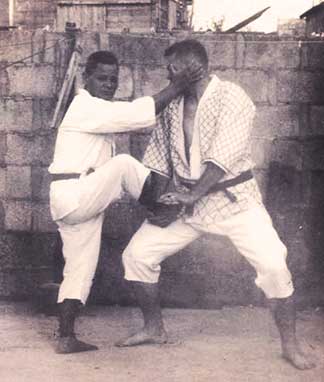
That’s my philosophy when it comes to applying the techniques of kata.
But still, many people struggle.
“What does this movement mean? What’s the purpose of this technique? How should it be used against an opponent?”
Most of us have never been taught bunkai in a coherent and structured manner.
(And if we have, it’s often been haphazardly, or as a “sidenote”.)
Why?
Because in 9 times out of 10, our instructors weren’t taught it either!
The consequences are devastating:
- People start to dislike kata (due to its abstract nature).
- People belittle its significance (since real-world applications are never shown).
- People make up their own kata (where the meaning of each movement is clear).
- People change the techniques of kata (to make sense of the movements).
- People stop caring about bunkai (satisfied with just having a “general overview”).
- People ignore kata altogether – leaving those “war dances” to us Karate Nerds™!
In short, many people just don’t see the purpose of exploring kata anymore.
It gives them migraine.
And frankly, I understand them.
I don’t like feeling stupid either.
But I can’t sit on the sideline of this trend no more – watching as our ancient kata get reduced to mere physical performances, or a bunch of awkward movements to be memorized for gradings and tournaments, without any real substance left.
Listen:
If you know several kata, but never take advantage of the ancient lessons they were originally meant to impart (bunkai), then you might as well be doing ballet.
That’s right.
Kata is a time-tested, prepackaged toolbox of kick-ass lessons – delivered through a bad-ass template of physical awesomeness – designed to save your ass on the street.
Agree?
So, I’ve decided to share a little *secret* with you today…
Introducing…
The Bunkai Blueprint.
A simple framework for applying the techniques of Karate’s kata.
(Without the migraine.)
You see, over the years I have developed a deceptively simple formula for understanding the movements of kata. A thought-process, or framework if you so will, for making sense of each movement in a kata – along with their practical applications for self-defense.
This blueprint can be applied to any kata from any style, as long as you are willing to put in some time, effort and attention.
I mean, sure, the original meaning of most kata has been lost in the “sands of time”.
But that doesn’t mean we can’t reverse-engineer this puppy.
Follow along:
The Core Premise
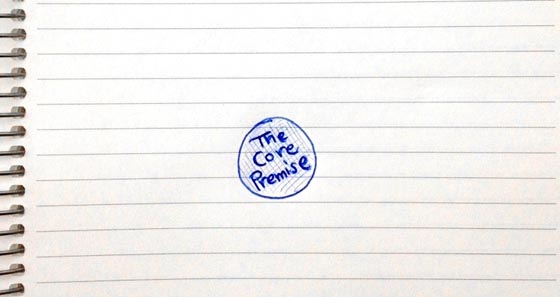
All right.
The first part of The Bunkai Blueprint relies on understanding a basic premise, or underlying stipulation, of traditional Karate – which will dictate the rest of our kata discovery process.
Thus, it is of paramount importance that one familiarizes, and ultimately internalizes the following Core Premise – since it provide the contextual mindset from which we will operate throughout the whole Bunkai Blueprint.
Check it:
- Karate was originally meant to be used for physical self-defense – most often against a single, untrained, probably right-handed, advantageous, unarmed and aggressive adversary.
- Kata is a mnemonic template (learning vehicle for retention and transmission of information) – handed down from our founders with the primary purpose of practicing the above exact point.
- Hence, the techniques of kata must, by pure logic, be based on principles that govern successful self-defense: Effective techniques that are simple to execute, easy to practice and fast to recall – while efficiently delivering a favorable outcome on our behalf.
The Core Premise, which has a lot of direct (and indirect) implications when you go deeper into the words, should be considered the marinade for the meat of The Bunkai Blueprint – which will grill our understanding of kata in the subsequent phases of this awesome bunkai barbeque.
Get it?
On to the next part.
The Supporting Concepts
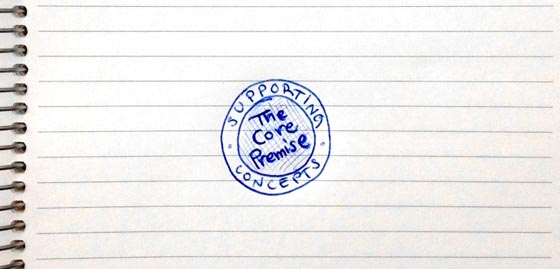
Now…
As practical extension of The Core Premise, we have The Supporting Concepts.
Although there are several important concepts to be known, I will just briefly introduce three major ones now, beginning with the HAPV.
The HAPV
The first of The Supporting Concepts, researched, catalogued and popularized by hanshi Patrick McCarthy, is the HAPV – Habitual Acts of Physical Violence. Put simply, the HAPV is a list of the 36 most basic techniques encountered and expected by civilians in an unarmed fight.
It goes like this:
1. Straight kicks
2. Angular-type kicks
3. Straight punches
4. Circular punches
5. Downward strikes
6. Upward strikes
7. Knee & elbow strikes
8. Head-butt/biting & spitting
9. Testicle squeeze
10. Augmented foot/leg trips
11. Single/double-hand hair pull from the front/rear
12. Single/double-hand choke from the front/rear
13. Front neck choke from rear
14. Classical head-lock
15. Front, bent-over, augmented choke
16. Half/full-nelson
17. Rear over-arm bear hug (& side variation)
18. Rear under-arm bear hug (& side variation)
19. Front over-arm bear hug (& side variation)
20. Front under-arm bear hug (& side variation)
21. Front/rear tackle
22. One-handed wrist grab (same & opposite sides-normal/reversed)
23. Two-handed wrist grabs (normal/reversed)
24. Both wrists seized from the front/rear
25. Both arms seized from the front/rear
26. Single/double shoulder grab from front/rear
27. Arm-lock (behind the back)
28. Front arm-bar (triceps tendon fulcrum up supported by wrist)
29. Side arm-bar (triceps tendon fulcrum down supported by wrist)
30. Single/double lapel grab
31. Single/double-hand shove
32. Garment pulled over the head
33. Seized & impact
34. Single/double leg/ankle grab from the front (side/rear)
35. Ground straddle
36. Attacked (kicked/struck) while down
Next up, I have some letters from the alphabet for you.
The ABCDE
(Remember?)
The goal of practical Karate should always be to survive unharmed.
Rather than harming the opponent.
So, although the inherently chaotic nature of self-defense can never guarantee any of those outcomes, we should strive to maximize our chances of survival by always aiming to attack the following human structures:
- Air
- Blood
- Consciousness
- Dislocation
- Escape
A: Air means blocking the air flow of our opponent, for example by restricting it with a choke.
B: Blood means restricting the blood flow of our opponent. Blood transports oxygen to our brain and other vital organs, which means that shutting it down (through a strangulation, for instance) will shut down the opponent – even faster than restricting air flow.
C: Consciousness refers to knocking the opponent out, making him/her lose consciousness. A solid hook to the chin might do the trick, but so will an elbow smash or a headbutt to the temple. As long as the goal is met.
D: Dislocation is pretty straightforward – it simply means we incapacitate our opponent, without him/her necessarily passing out as a consequence (although it might happen due to shock, depending on the degree of trauma inflicted). Just remember that it takes more than a dislocated finger to stop somebody.
E: Escape is, of course, the ultimate goal in self-defense. (But hey, if we could always escape, what’s the point of practising this stuff anyway?)
(Fun sidenote: When I visited Hawaii earlier this year, for some Karate adventures, I heard of a girl whose parents named her “ABCDE”. Apparently, it was pronunced “Ab-see-dee”. Needless to say, my faith in humanity has still not been properly restored.)
Lastly, we have a third major component of The Supporting Concepts.
I’m talking about…
Human Anatomy
Look:
While it’s often fun to use strength, speed or flexibility as an advantage in the dojo, we must always assume that an assailant on the street will be physically superior (and perhaps even mentally fortified), and will most likely have the element of surprise to his/her advantage.
Hence, we need to understand the principles of Human Anatomy in order to maximize our chances of bunkai success.
The human body is the principal subject in all empty-handed physical violence, no matter where you live or who you are, therefore it’s vital to study Human Anatomy in order to learn how its unique structures and universal anatomical weaknesses can best be exploited and attacked when confronted with a HAPV in order to achieve the ABCDE with our bunkai.
Simply put, even a rudimentary understanding of anatomy will allow you to see what regular people would need years of hands-on experience to perceive.
Like:
- The optimal anatomical location of any given attack and/or defense (groin, eyes, ribs, solar plexus, throat, knee etc.)
- The optimal human weapon to use in each instance of attack and defense (fist, foot, elbow, knee, head, fingertips, etc.)
- The optimal angle, direction, frequency, timing, combination, intensity etc. of attacks and defense (tactical and strategical topics).
But in order to use this knowledge to your full advantage, you cannot allow yourself to be limited by the traditional labels of Karate techniques anymore.
Techniques must instead be considered movements, without any specific labels or names, since their usage could range anywhere from regular percussive impact to seizing and pressing into cavities, manipulating connective tissue, hyper-flexion, extension and over-rotation (dislocation) of joints, restricting blood and air flow, shutting down neurological structures, displacement of balance, attacking pressure points, eliciting common flinch reflexes/nerve reactions etc.
Understanding the Human Body allows you to easily assess what, where, how and why certain techniques will – or won’t – work.
And with those basic concepts acting as the functional support of our original premise, we are now ready to delve into the first part of the more practical section of The Bunkai Blueprint.
It’s time to choose your kata, break it down, analyze it and finally apply it.
Follow me.
Bunkai – Break it Down
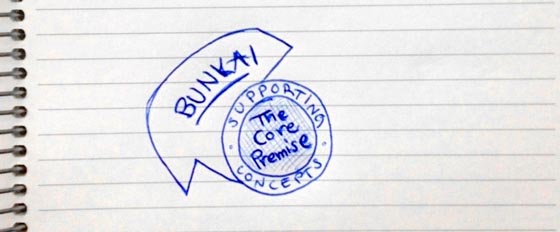
I know what you’re thinking.
I’m the new Picasso, baby.
Anyway, drawing skills aside, the word “bunkai” – which literally means “to break down” in Japanese – has generally come to represent the whole process of breaking down, analyzing and applying the techniques of Karate’s kata.
And that’s fine for regular people.
But in actuality, Bunkai is just the first practical step for unlocking the secrets of kata (with The Core Premise and The Supporting Concepts acting as theoretical backdrop) – before moving on to Bunseki (Analyze it) and Oyo (Apply it) in order to complete the circle of The Bunkai Blueprint.
Hence, Bunkai, or “breaking down”, should just be considered the groundwork.
Some integral questions to be asked in the Bunkai phase is:
– Does my kata actually have any cool applications? Some kata were created for the simple purpose of teaching physical education to kids, through the means of Karate movement. In those cases, the form of the kata was prioritized over the function of the kata. Other kata were created with a specific goal in mind; like synchronizing your body with your breathing. In other words, the first step is to choose your kata wisely. Like my colleague Iain Abernethy once put it; “…punching a bag for an extended period of time can improve your health. However, punches weren’t designed to improve your health; they were designed to damage the health of others”. And the same goes for kata. Choose a good kata.
– How are the various sequences (combinations/FRU [Functional Rhythm Units]) of the kata divided? Once a kata has been chosen, we now break it down (“bunkai”) even further. Although a kata initially seems to be nothing but a long string of separate techniques, there are actually smaller combinations of interlinked techniques within the kata (typically 1-5 movements). These can be referred to as defensive templates, or using the scientific terminology of Dr. Lucio Maurino, various sets of Functional Rhythm Units (FRU). Looking at the rhythm of kata, you will easily find these defensive templates, and it is very important that you do; because the rest of the process will make no sense if you choose the wrong place to start/end each bunkai.
– Of those smaller combinations, what sequence seems to be the easiest to figure out? Addressing the easiest combination of techniques first will help you provide the context for understanding the harder ones later. As a personal suggestion, the beginning/end are often best (the first and last sequences in the kata), since the start/stop of those defensive templates is already ‘built-in’ and will save you some brain juice.
And so on.
Like you can see, each question inevitably leads down a path of more questions, but the main idea is to always follow the definition of the word ‘bunkai’ – to break down the whole kata into manageable pieces of further analysis.
Which is a perfect segue into the next part.
Bunseki – Analyze it
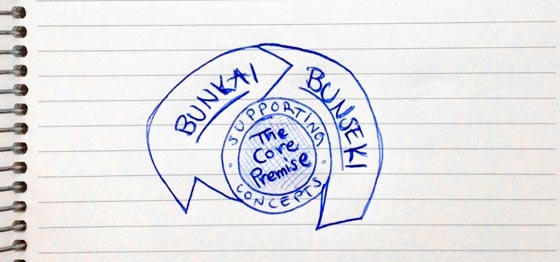
Okay.
Now that you’ve chosen your first part of a kata to work with, it’s time to put the rest of the kata on the back burner – and just focus on this particular part.
You see, knowing 168 different applications for a technique means little unless you know why a technique is included at a particular point in the kata – and that’s what we’re trying to figure out right now.
So let’s analyze it (= ‘bunseki’ in Japanese).
Continuing with the inquisitive approach (i.e. asking ourself a bunch of question), we will now look at the first movement from our chosen 1-5 move sequence, and we will start from the legs (the foundation), since they directly influence how our upper body functions.
A couple of logical areas of inquiry:
– Stance: Contrary to popular belief, stances do serve an important purpose. But they have more with the relative position (and subsequent/preceding transfer) of your bodyweight to do, rather than “how many degrees my big toe should be pointing”. So ask yourself this: Where is the majority of my weight centered? To the front? (Zenkutsu-dachi) Side? Back? (Kokutsu-dachi) Down/Center? (Shiko-dachi/Kiba-dachi/Nekoashi-dachi) Single-leg stance? (Tsuru-ashi-dachi) Close quarters combat? (Sanchin-dachi) etc. Why is that so? Consider how changing the stance would change the effectiveness of your technique. There’s a reason for every stance.
– Movement: What direction are you moving in? Towards an opponent or away from an opponent? Is the first movement defensive or offensive in nature? The direction and stance will help you tell. If it’s a turn: Are you moving your front leg or back leg? Why? There is a purpose. Are you stepping or sliding? Jumping or dropping? Standing still? Why? Could a step be considered a kick, knee strike, shin block or even sweep? In the end, all movements are nothing but ways of transferring your mass (or parts of your mass) in various directions. Consider why, and how, changing a movement might change the effectiveness of your technique.
– Lower/Upper Body Interaction: Before moving on to the upper body, you need to check something: Does your preconceived notion of your upper body (arm/hand techniques) match your conclusions about your lower body (i.e. stance, movement, direction, body weight distribution)? If not, reconsider what the arms/hands are doing, and how your upper and lower body interacts. In the end, they should be working as a unit
– Hands: Are your hands open or closed? Open hands can represent a release of a hold, or catch. Closed hands can represent a grab, or joint manipulation. Strikes and/or blocks with open or closed hands have different applications. Pay special attention to your “passive” hand. Because there is no such thing. Both hands have a purpose, just as both legs do. Is your hand by the hip? Is it by the head? Is it in some weird contortion? Why? A hand might sometimes look passive when it’s defending your centerline, or after deflecting an attack (while your “active” hand is busy) – but there’s always a meaning. Is your “passive” hand holding something? Open or closed? Just escaped from a grip? Preparing for something? Grabbing your opponent? Consider the various options.
– Tempo: Is a movement fast or slow? Does the rhythm change over the course of the movement? Slower movements might represent pressing motions, joint manipulation or submission holds, while fast movements might represent direct attacks, breaks/escapes, throws/trips and deflections/blocks. There’s a reason some techniques are always done slowly, while others are fast.
– Non-obvious movements: Try flipping the script. Is a hikite (withdrawing hand) actually a backwards elbow strike? Is a step actually a knee strike? Is a turn actually a throw? Is a forward lean a headbutt? Or an ass-bump? Try to see beyond the obvious.
On it goes.
Simple questions like these will give rise to further questions – which is fantastic – because you’ll need to use this approach for each technique of your bunkai, until you have analyzed all reasonable possibilities.
Fun, fun, fun!
So now that you’ve got some sense of what you’re doing (Bunkai – Break it Down), and why you’re doing it (Bunseki – Analyze it), let’s check out how you do it – by bringing a partner into the equation.
Check it out:
Oyo – Apply it:

Observation:
Most people begin in the wrong end when they try to figure out bunkai.
They ask a partner to attack them, and then, *fingers crossed* they hope to apply some random kata move. In The Bunkai Blueprint, however, this is the last thing you do. You do it now – when you have a solid understanding of the actual moves you are about to apply, and how to best apply them.
Like we say in Japanese: “honmatsu tentou” (don’t put the cart before the horse).
Time to get a partner and bang out some moves.
Here are the main considerations for the Oyo (Jap. “application”) phase:
– Begin from a natural position of self-defense. Not a boxing guard. Not a crane stance. This is self-defense, remember? If not, read The Core Premise again. The opponent might be situated to your left, right or back. Not just front. Never presume the luxury of a mano-a-mano square off.
– You alredy know your own movement. But you don’t know the attacker’s movement. So try to apply your bunkai against many different attacks. A grab. A punch. A grab/punch. A punch/grab. A double grab. A double punch. A shove, punch, double grab. A slap. You should figure out pretty fast what kind of HAPV attacks fit your moves. Remember The Supporting Concepts here.
– Your opponent must react to your techniques. Kicked in the groin? Bend over. Finger jab to the eyes? Flinch. These predetermined, biological responses will dictate the success rate of your techniques. Therefore it’s important that your training partner “plays along”. (If not; do it for real). Your training partner should understand Human Anatomy too, you know.
– But your opponent isn’t Bruce Lee. If your defense relies on a fixed combo of attacks/steps/blocks from the opponent, something is wrong. We’re not mind readers here. However, your techniques should still take advantage of the predetermined physiological reactions elicited by your opponent’s pain withdrawal response system. Or else its not realistical. But don’t predict stuff.
– Kata have no “hidden” techniques. But techniques might change depending on the circumstances (i.e. environmental factors, your opponent’s reactions, fighting spirit etc.). In other words, you should be prepared to do a tactical pivot at any time. Like Funakoshi Gichin, the founder of Shotokan Karate once said: “Following a kata exactly is one thing, engaging in a real fight is another.”
– Passive resistance or active resistance? A technique might work very well against somebody who is your friend in the dojo, using only passive resistance against you. But, against somebody offering active resistance? That’s a whole ‘nother story. Suddenly, a big kiai seems more relevant than ever.
And that’s it for now.
Once you’ve gotten hang of the Oyo part, and can successfully apply your sequence against a moderately aggressive opponent, start with a new Bunkai/Bunseki/Oyo cycle from the same kata, until you’ve deciphered the whole thing.
However, it would be foolish to just “start over” in each phase!
The lessons you learned from each stage (Bunkai/Bunseki/Oyo) should be carried over to the next stage, in the form of principles, to act as continually evolving, underlying, foundations for progress.
Like this:
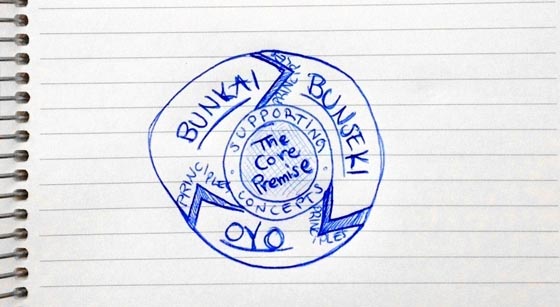
You see, techniques will always vary between kata, styles, masters and schools. There is no way we can ever know if we are doing the “right”, “original” or “best” bunkai/kata/technique in universe.
But principles never change.
They are universal.
(Otherwise they wouldn’t be principles).
And once those combative principles are identified, you will literally be dishing out bunkai faster than you can say “Funakoshi’s Fantabulous Falafel Fraternity”.
Now…
There’s only one last thing to add before The Bunkai Blueprint is complete.
A Vitamin Injection
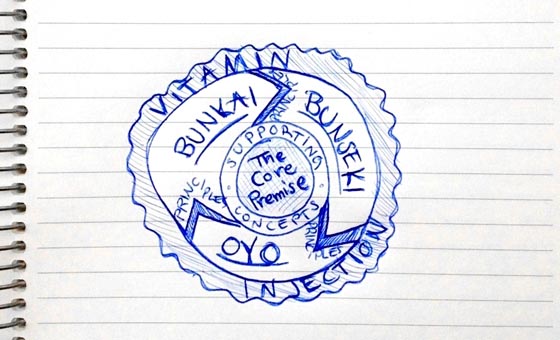
Like the name implies, a Vitamin Injection is anything that acts as a source of inspiration, information or motivation when you’re stuck.
Because believe me – you will get stuck.
Vitamin Injections can be added at any moment during The Bunkai Blueprint process.
Here are some examples:
- Look at other martial arts – What are they doing? What can you learn from that?
- Look at other historical variations of your kata – What can you learn? (e.g. Bassai Dai, Bassai Sho, Matsumura Bassai, Tomari Bassai etc.)
- Look at the same kata in other styles – Is there anything else in common, beside the name? (i.e. kata Seisan exists in Shito-ryu, Goju-ryu, Uechi-ryu, Isshin-ryu, Shotokan (under the name Hangetsu), Shorinji-ryu, Wado-ryu etc.) – What can you learn from cross-referencing those?
- Use media; like YouTube, books, videos, DVDs, blogs and online forums. Call your sensei, ask somebody who trains somewhere else, ask somebody who trains nothing else. How would they do it? Think outside the box.
- Add dirty techniques. Unconventional methods. Biting. Eye gouging. Spitting. Fish-hooking. Make it work. If there is a small tweak you can do to make a technique work, do it. We have no idea what the exact original movement looked like anyway – 10% wiggle room for experimenting is totally fine. But don’t force a square peg into a round hole.
- Question your assumptions about everything. Re-read The Core Premises. Are you misinterpreting something? Read The Supporting Concepts again. What area do you need more knowledge in? Be honest. Find out. Research. Try again.
- Pretend you are a beginner. How would you approach it?
- Pretend you are Bruce Lee. How would you approach it?
- Tweet me @KARATEbyJesse and ask for help. (Or send me an e-mail.)
- Read everything again. And again.
- Sleep on it.
- Etc.
Everything that acts as an extra stimulant should be considered a Vitamin Injection.
And with those words I conclude my brief presentation of The Bunkai Blueprint: A Simple Framework for Applying the Kata of Karate in Practical Self-Defense.
What do you think?

Cool? Useful? Nerdy?
The Bunkai Blueprint is still a work in process – so I’d appreciate any feedback/help to make it better. Was anything unclear?
Leave a comment and let me know.
/Jesse
* PS. If enough people share this, I might even improve it: More explanations, real graphics, cool photos and illustrations, real-world “case studies” and bonus videos.
Again, just leave a comment and let me know.
(And use those share buttons below!)
Thanks for reading – good luck!
“Kata are not some kind of beautiful competitive dance, but a grand martial art of self-defense – which determines life and death.”
– Kenwa Mabuni (founder of Shito-ryu Karate)
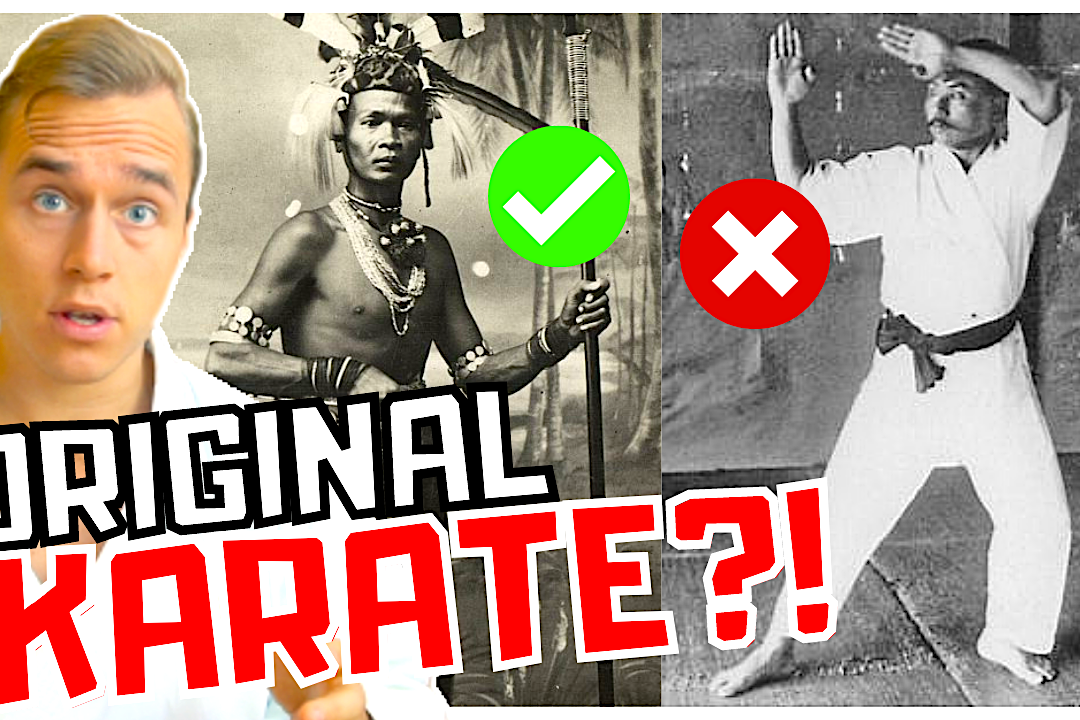
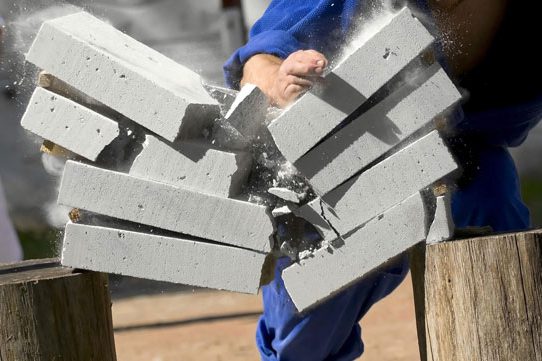
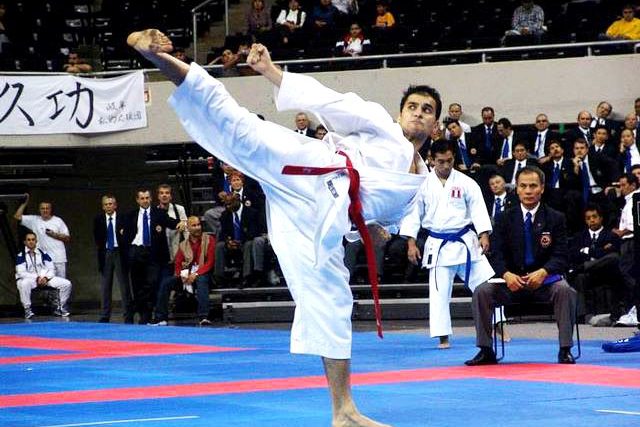
64 Comments